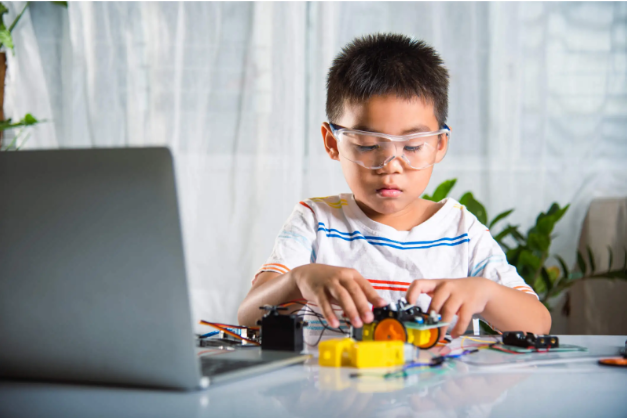1668A, 14th Main Rd, Sector 7, HSR Layout, Bengaluru, Karnataka 560102
+91 99459 30733 (9am - 6pm IST, Saturday - Sunday) (10am - 7pm IST, Tuesday - Friday)

In a quiet suburb, a group of children gathers around a table, eyes wide with anticipation. In the center lies a captivating puzzle of gears, wires, and tiny motors – the foundation of their own robot. This scene is becoming increasingly common as robotics for kids takes center stage in the realm of education and play. As technology continues to weave itself into the fabric of our daily lives, the demand for cultivating young minds in science, technology, engineering, and mathematics (STEM) fields has never been more critical. In this blog post, we'll explore the exciting world of robotics for kids, delving into the transformative impact it has on their development and citing data to support the growing trend.
The fascination with robots has long captured the imaginations of children, and educators and parents alike are leveraging this enthusiasm to foster a love for learning. According to a 2023 report by STEM.org, an organization dedicated to advancing STEM education, the adoption of robotics programs in schools has seen a remarkable 25% increase over the past five years. This surge reflects a collective recognition of the need to equip the younger generation with the skills necessary for the tech-driven future that awaits them.
Beyond the sheer enjoyment of building and programming robots, there's solid evidence that engaging with robotics positively influences academic performance. A study conducted by the National Center for Education Statistics found that students involved in robotics programs consistently outperform their peers in standardized tests, particularly in mathematics and science. The interactive and hands-on nature of robotics not only makes learning enjoyable but also cements abstract concepts through practical application.
As the world strives for greater gender inclusivity in STEM fields, robotics programs for kids have emerged as a powerful tool in breaking down traditional gender barriers. According to a study by the American Association of University Women, girls participating in robotics activities exhibit increased confidence in their mathematical and scientific abilities. Moreover, these programs actively challenge stereotypes, nurturing an environment where both girls and boys can explore their potential without predefined limitations.
The essence of robotics lies in problem-solving and critical thinking – skills that are crucial in navigating the challenges of the 21st century. Data from the World Economic Forum highlights that these skills are among the top priorities for future workforce readiness. By engaging in robotics, children learn to approach problems methodically, analyze information, and collaborate with their peers, building a strong foundation for success in various aspects of their lives.
One of the most captivating aspects of robotics for kids is its ability to unleash creativity and spark innovation. As children assemble and program their robots, they are not merely following instructions; they are inventors crafting their solutions. According to a study published in the Journal of Educational Psychology,
The Social Impact of Robotics for Kids:
Robotics programs extend beyond the solitary pursuit of building and coding. Collaborative projects and team-based challenges are integral components of many robotics curricula. As children work together to solve problems and accomplish tasks, they enhance their social skills, communication abilities, and teamwork.
A report from the National Education Association (NEA) highlights that participation in group-based robotics activities contributes to improved social interaction, empathy, and a sense of community. These skills are not only vital for success in future professional endeavors but also for cultivating a generation that values collaboration and collective problem-solving.
The rise of robotics for kids is not confined to a particular geographic region. Countries around the world are recognizing the significance of integrating robotics into their educational frameworks. According to data from the Organization for Economic Co-operation and Development (OECD), several nations, including South Korea, Finland, and Singapore, have witnessed substantial growth in the incorporation of robotics education in primary and secondary schools.
These global initiatives indicate a shared understanding of the importance of preparing the next generation for a technology-centric future. The collaborative efforts of educators, policymakers, and parents worldwide underscore the universal belief in the transformative potential of robotics in shaping well-rounded, future-ready individuals.
While the adoption of robotics education is on the rise, it is crucial to ensure that these opportunities are accessible to all children, regardless of socioeconomic background. Organizations and initiatives, such as FIRST Robotics and Robotics Education & Competition Foundation, are actively working to bridge this gap by providing resources, scholarships, and support to underserved communities.
The inclusivity drive is not limited to economic considerations; it also addresses diversity in gender, ethnicity, and neurodiversity. Robotics programs catalyze breaking down barriers, offering a level playing field where children from diverse backgrounds can explore their potential and contribute meaningfully to the ever-evolving landscape of STEM.
In the heart of this robotic revolution for kids lies a promise – a promise to equip the next generation with the tools they need to thrive in a dynamic and technology-driven world. As we witness the impressive statistics, delve into research findings, and embrace the stories of children discovering the joys of robotics, it becomes evident that we are laying the foundation for a future where innovation knows no bounds. The journey may be filled with gears, wires, and intricate programming. Still, it is also marked by the boundless creativity, collaboration, and curiosity that will propel us into an exciting and ever-advancing future.
As we witness the burgeoning interest in robotics for kids, it's clear that we are shaping a generation poised to embrace the complexities of an increasingly technological world. The statistics and studies presented here underscore the transformative impact of robotics education on academic performance, gender inclusivity, and the development of critical skills. Through the enchanting medium of robotics, we are not only fostering a love for learning but also preparing our children to become the architects of tomorrow's innovations.